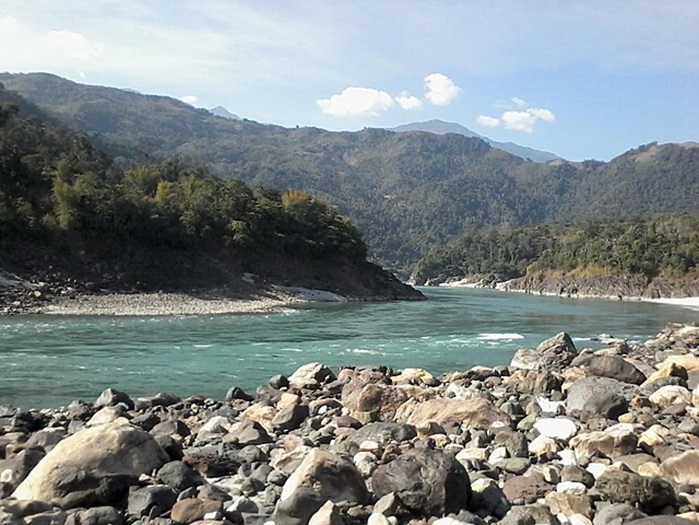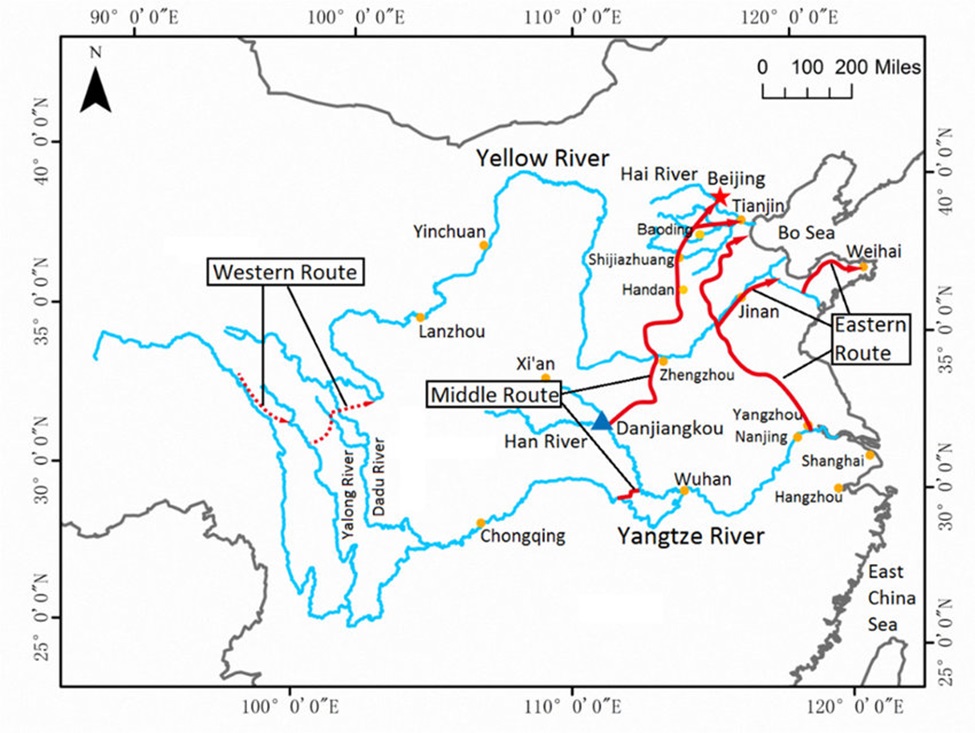
The River Siang in Arunachal Pradesh

China’s proposed construction of the dam on the Yarlung Tsangpo
China has proposed the construction of a 60,000 MW (60 GW) Hydropower Project in Medog county, just 30 km from the international border close to the Indian state of Arunachal Pradesh, on the Yarlung Tsangpo, also known as the Brahmaputra in India. There have been reports that China plans to divert the Yarlung River through the construction of a South-North Diversion Project which will be 1,000 km in length.
Since people in both Arunachal Pradesh and Assam are heavily dependent on the Brahmaputra river for their quotidian water needs, the diversion of lean season flows will affect their day-to-day existence. Similarly, the diversion will affect the flora, fauna and river ecology of the region. Moreover, the diversion of the Yarlung Tsangpo (Brahmaputra) to the north by China during the lean season will reduce the flow of the Brahmaputra river. This will adversely impact run-of-the-river projects like Lower Siang. Finally, a large volume of water storage by China at the Great Bend could act as a catalyst in creating artificial floods during monsoons endangering populations living in the Indian states.
According to a report in CGTN TV on February 5, 2023, China has already diverted 60 billion cubic metres of water since November 2013 from the major rivers in the south to meet the water demands of the drought-prone regions of Northern China. This mega project has three routes (see map below), two of which have started operations. The middle route starts at the Danjiangkou Reservoir Project in Hubei Province and runs across Henan and Hubei before reaching Beijing and Tianjin. The eastern route transfers water from China’s Jiangsu Province to areas including Tianjin and Shandong. The Western Route is yet to be built.

Upper Siang Hydroelectric Project (11000 MW)
In the event of the construction of the 60 GW Project at the Great Bend by China, the feasibility of the Lower Siang Hydroelectric Project (2,700 MW) in India, which is a run-of-the-river project, will be severely affected. The construction of Upper Siang Hydroelectric Project (HEP) with large water storage in the reservoir, on the other hand, will keep the river alive during the lean season and will also absorb any flood water released by China after the 60 GW hydroelectric project at the Great Bend is constructed.
The proposed location of the Upper Siang Hydroelectric Project is in the Upper Siang district of Arunachal Pradesh, with its headquarters at Yingkiong. The National Hydroelectric Power Corporation (NHPC) and the North Eastern Electric Power Corporation (NEEPCO) have jointly been assigned the task of construction of this project. On 30 December 2022, NHPC submitted a pre-feasibility report of the Project according to which the installed capacity of the project would be 11,000 MW, the reservoir would have a storage capacity of 9 billion cubic metres (BCM) and the estimated cost of the project would be around Rs. 1,13,000 crores (US$ 13 billion). Investment of such a large magnitude in Upper Siang district in Arunachal Pradesh would have a multiplier effect on the economy of the state and lead to improvements in the infrastructure of this remote district. For instance, the approach road from Assam.
Direct Benefits of Upper Siang Hydroelectric Project to Arunachal Pradesh
Notably, out of the total annual electricity generation of about 47,000 MU in a 50% mean year, 12% will be given free to the state of Arunachal Pradesh, as per the policy of the Government of India. The annual share of free energy at 12% to the state of Arunachal Pradesh will be around 5,640 MU. This indirectly means that Arunachal Pradesh, in terms of installed capacity will get 1320 MW of power, free of cost. At the time of the commissioning of the Upper Siang Project, the average rate of sale of electricity in the market may be around Rs 6.00 to Rs 7.00 per unit. Thus, even by considering a sale rate of Rs 6.00 per unit of electricity, Arunachal Pradesh will get additional annual revenue of around Rs 3384 crore from free power from this project in a normal year. In addition, 1% of total revenue from the project will be distributed among the local population in the project affected area. This means an additional generation of revenue of around Rs 282 crore would be distributed to the project-affected people.
In addition, every family affected by the project will be entitled to get 100 units of free electricity as per the provisions enshrined in the National Hydro Power Policy 2008. This permanent annual income would be in addition to the Rehabilitation and Resettlement compensation to be given to the project-affected population for acquisition of their land and property for construction of the project.
The Upper Siang Hydroelectric Project, once constructed, will become the backbone of the Arunachal Pradesh economy and will usher in an era of prosperity in the State, providing meaningful employment to the local youth and generating economic opportunities for the local population. Fish breeding in the 125 km length of the reservoir would enhance the income of the local population. Water transport for the people in the higher reaches in precipitous hilly terrain and water sports activities in the reservoir will be another attraction that will generate revenue to the local people on a permanent basis.
Impact of Climate Change in Arunachal Pradesh and its mitigation by Upper Siang Hydroelectric Project
This project will play a major role in combating the impact of climate change in the Brahmaputra basin by keeping temperature rise commitments in consonance with the 2015 Paris Agreement, and achieving net zero carbon emission targets committed to during the COP26 Climate Summit in Glasgow and the COP27 held in Sharm El-Sheikh.
The construction of the Upper Siang Multipurpose Project will enable India to move quickly on the path of energy transition by phasing down coal generation to non-fossil fuel renewable energy. It will prevent the release of approximately 32 million tonnes of CO2 annually into the atmosphere, presently being released from coal based power generation.
A recently concluded study on climate change in Arunachal Pradesh by the author reveals that the present average annual temperature of 29o C will increase by 1.5° to 2°C by the year 2060 and a 2.3° to 2.8°C rise by 2100. This study also depicts that the present average annual precipitation of 2987 mm will decrease up to 7.5% to 10.2% in the near future by the year 2060. This annual precipitation will decrease by 8.4% in the far future by the year 2100 in case of SSP1-26 (sustainability pathway with low energy demand) and will increase by 2.9% in case of SSP5-85 (fossil-fuelled development pathway). Spatial and temporal distribution of rainfall would, however, undergo significant change. Effects of global warming and climate change risks can be mitigated with corrective measures such as reducing dependency on fossil fuel power generation, storing water in dams to meet irrigation, drinking water and industrial water needs while at the same time generating hydropower. Construction of dams in India to address water and energy security needs is essential. Against this overall context the construction of the Upper Siang Dam will be a step in the right direction.
Renewable Energy and Grid balancing by Upper Siang Hydroelectric Project
While solar and wind power generation have seen exponential growth in India in the past, a lot more work is required. Till the end of September 2023, the total installed capacity of renewable energy in India was 178633 MW, out of which 71780 MW came from solar, 46850 MW from hydro, 44184 MW from wind, 4983 MW from small hydro, 10262 MW from biomass and 573 MW from waste to energy. By the year 2030, the installed capacity of renewable energy is expected to increase to about 500,000 MW. It is well known that both solar and wind are intermittent sources of energy which suffer from variability and uncertainty, are location-specific and have a low capacity factor. With the significant injection of solar and wind renewable into the grid, storage dams with hydropower generation including pump storage have become the backbone of energy transition. The Upper Siang Hydroelectric Project (11,000 MW) with water storage of 9 BCM will provide grid stability and will also help in the integration of large scale renewable energy in the system.
Hydropower is the only reliable energy source which can be effectively ramped up and down as per demand. It holds a unique place amongst all other energy sources and plays a crucial role in ensuring grid stability. Sustainable hydropower is a clean, green, modern and affordable solution to climate change.
Water stored in Upper Siang Dam will be crucial in ensuring water security for the populations, keeping in mind the nature of extreme climatic events that have affected the region since the advent of climate change. With its inbuilt storage capacity, this project will reduce the intensity of floods in the Siang basin in Arunachal Pradesh and in the Brahmaputra basin in Assam. It will also ensure reliable water flow in the Siang river and Brahmaputra river during the lean season thus providing water security to the North Eastern Region.
Conclusion
The positive impact of this project could be negated by the diversion of the Yarlung Tsangpo by China to the north. It is therefore imperative that work on the Upper Siang Dam progresses at a fast pace and there are no further delays in its implementation.
With a hydroelectric potential of 50,000 MW, India’s North-East could offset China’s proposed diversion of Yarlung Tsangpo. The Upper Siang Hydroelectric Project will be key to the development not just of Arunachal Pradesh but of the entire North Eastern Region. We cannot afford to waste more time on the initiation of the Upper Siang Hydroelectric Project.
(Exclusive to NatStrat)